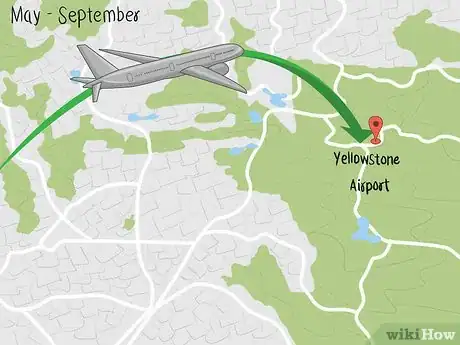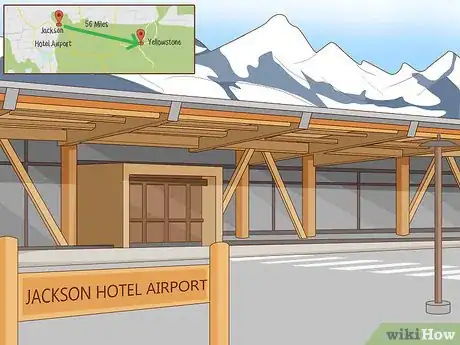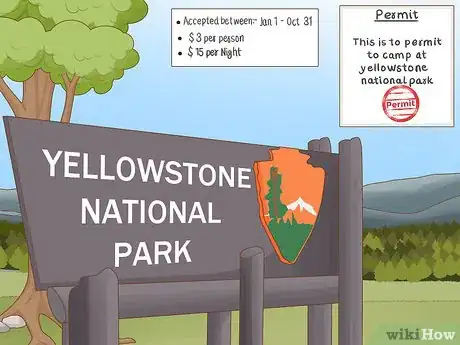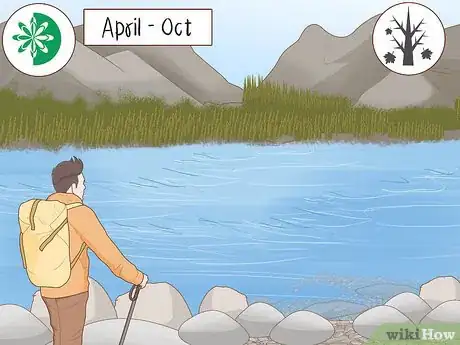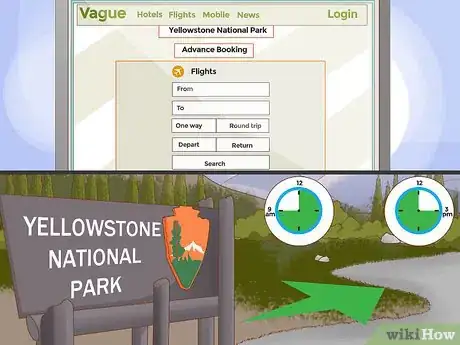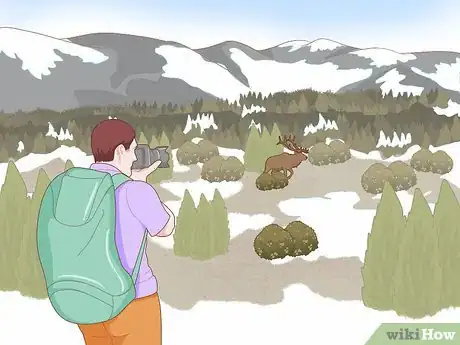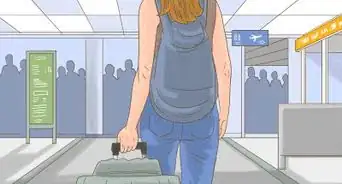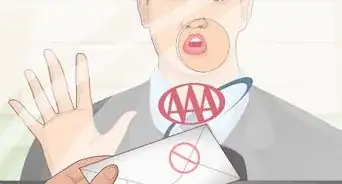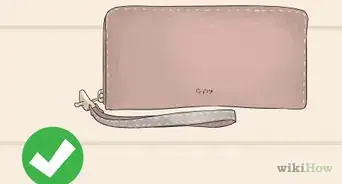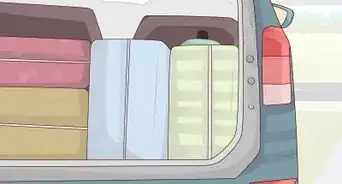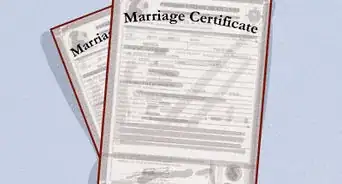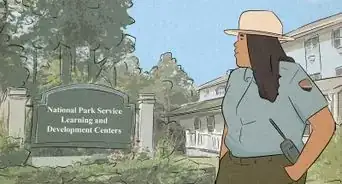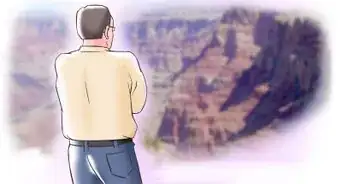This article was co-authored by wikiHow Staff. Our trained team of editors and researchers validate articles for accuracy and comprehensiveness. wikiHow's Content Management Team carefully monitors the work from our editorial staff to ensure that each article is backed by trusted research and meets our high quality standards.
There are 7 references cited in this article, which can be found at the bottom of the page.
This article has been viewed 14,901 times.
Learn more...
Yellowstone is one of the biggest and most beautiful parks in the world and is home to an endless array of wilderness and wildlife. The park’s 2 million-plus acres feature majestic peaks, a vast expanse of geysers, dozens of species of mammals, and hundreds of species of birds. There are a few different ways to get to Yellowstone, including by plane and by car. While public transportation in the area is sparse, it is possible to take a bus to nearby towns and rent a car from there.
Steps
Flying to Yellowstone
-
1Fly into Yellowstone Airport from late May through September. This airport is just 2 miles (3.2 km) north of the west entrance of the park, making it the closest airport to Yellowstone National Park. You will have to fly through Salt Lake City, as this is the only big airport that goes to Yellowstone Airport.[1]
- If you’re on a bit of a budget, consider renting a car from Salt Lake City. It’s a scenic drive that runs about 300 miles (480 km) long.
Warning: Airfares to small airports right near the park can get pricey, so look into this option as you plan your trip.
-
2Go through Jackson Hole Airport at any point in the year. There are a number of different airlines that fly into Jackson Hole Airport. The airport is only 56 miles (90 km) from the Southern entrance of Yellowstone and the drive there is gorgeous.[2]
- Jackson Hole Airport is actually right in Grand Teton National Park, so if you want an appetizer to your Yellowstone trip, consider exploring Jackson Hole beforehand!
Advertisement -
3Get to Yellowstone any time of year by flying through Bozeman. Bozeman Yellowstone International Airport in Montana is within 100 miles (160 km) of Yellowstone National Park. Once you fly into Bozeman, you can take U.S. 191 to get to the West Yellowstone entrance. You can also drive east on I-90 to get to Livingston and then drive south on U.S. 89 to get to the Gardiner entrance.[3]
- It’s 87 miles (140 km) on U.S. 191 from Bozeman to Yellowstone. If you’re using I-90 and U.S. 89, it’s 20 miles (32 km) on I-90 followed by 53 miles (85 km) on U.S. 89.
-
4Try Billings Logan International Airport if Bozeman is too busy. Bozeman Yellowstone International Airport is the biggest and busiest airport in Montana. If you’re having trouble finding flights that fit your schedule, check out Billings Logan International Airport. Numerous commercial flights fly into Billings year-round, and it’s not too far from Yellowstone. The airport is only about 95 miles (153 km) away from the park.[4]
- From Billings, it’s a 65 miles (105 km) drive south on U.S. 212 to Red Lodge, followed by a 30 miles (48 km) drive on the Beartooth Highway to Cooke City, which is the northeast Yellowstone entrance.
Taking a Road Trip
-
1Drive directly from your home or an airport. Many tourists will drive around Yellowstone to take in as much of it as they can. If you’re coming from west of the park, take U.S. 20 or U.S. 191. To enter the park from the south, take U.S. 191. From the east, U.S. 20 is your best bet. The northeast entrance of Yellowstone is accessible from U.S. 212, while you can reach the north entrance from U.S. 89.[5]
- If you want to fly to a nearby airport, you can rent a car from any of them.
Tip:
Salt Lake City is 390 miles (630 km) from Yellowstone.
Denver is 563 miles (906 km) from Yellowstone.
Las Vegas is 809 miles (1,302 km) from Yellowstone.
-
2Hop on a bus to go from the airport to a gateway town near the park. While public transportation is sparse, there are some bus companies that will take you from the airport to near Yellowstone. Tickets for a one-way trip cost around 100 dollars. [6]
- Some resorts near Yellowstone offer shuttle services to and from specific airports. Check with your resort to see if this is a possibility for you.
-
3Rent an RV to camp out at Yellowstone without leaving your vehicle. You won’t ever have to unpack your bags or share a flight or bus with other travelers. Be sure to mark down the length of your RV when fully open, as sites that can accommodate units 40 feet (12 m) or longer are limited. Some camp sites require reservations to stay there during your trip, so book those months in advance.[7]
- Gasoline is sold in gateway cities, but only in a select few locations in the park itself. Make sure you fill up your entire tank before making the trip to Yellowstone. RV’s generally don’t get great gas mileage, so make sure you budget out how much you’ll be spending on gas before your trip.
-
4Secure a permit or reservation to camp out at Yellowstone. Reservations are accepted between January 1 and October 31, however, they must be submitted by fax, mail, or person. Note that reservations cannot be made over the phone or by email. Then, when you get to the park, you must pick up your permit in person in order to stay overnight.[8]
- The permit costs 3 dollars per person per night with a max of 15 dollars per night. You can also pay a 25-dollar fee to reserve a spot at a site.
- Reservations received by March 31 will be processed in random order starting April 1. Reservations made after April 1 will be processed in the order they’re received after the lottery is complete.
- When your reservation is received, a confirmation notice will be emailed to you. This is not a permit! To convert this into a permit, visit the office closest to where your trip begins. You can pick up your permit no more than 48 hours before your trip starts.
Enjoying Your Yellowstone Experience
-
1Travel to Yellowstone in the spring or fall to avoid the biggest crowds. Hundreds of thousands of people visit Yellowstone during the months of June, July, and August, so if you want a more peaceful experience, head to the park in April, May, September, or October. The weather is still good these months and the crowds are significantly smaller than during the summer.[9]
- All roads are open by the end of May, making spring a great time to see as much of the park as you can. You can bike, hike, and watch wildlife, like bison and elk during this time of year.
- During the fall, you can see colorful foliage as well as hordes of elk, grizzly bears, and black bears.
Tip: If wildlife-watching is a top priority for your trip, fall is an excellent time to go.
-
2Reserve lodging well in advance if you plan on going in the summer. Make your reservations for flights and accommodations at least 3 months prior to your trip, as the closest lodges fill up quickly during peak tourism season. When you’re at the park itself, go before 9 am or after 3 pm to avoid the biggest crowds of the day.[10]
- As you prepare for your trip, check out Yellowstone’s trail system to find hiking trails off the beaten path.
-
3Get to Yellowstone in the winter for a unique, intimate experience. This is a costlier way to see the park, as most roads are closed to vehicles. The best way to view the park during this time is on snowmobiles with an authorized guide. Be on the look out for bison trudging through the snow if you go during these months![11]
- Even though most roads are closed, there are miles of groomed trails that are perfect for cross-country skiing or snowshoeing.
References
- ↑ https://www.frommers.com/destinations/yellowstone-national-park/planning-a-trip/getting-there
- ↑ https://www.yellowstonenationalpark.com
- ↑ https://www.frommers.com/destinations/yellowstone-national-park/planning-a-trip/getting-there
- ↑ https://www.frommers.com/destinations/yellowstone-national-park/planning-a-trip/getting-there
- ↑ https://www.frommers.com/destinations/yellowstone-national-park/planning-a-trip/getting-there
- ↑ http://www.yellowstone.co/gettinghere.htm
- ↑ https://www.yellowstonepark.com/where-to-stay-camp-eat/rv-tips
- ↑ https://www.nps.gov/yell/planyourvisit/backcountryhiking.htm
- ↑ https://www.nps.gov/yell/planyourvisit/index.htm
